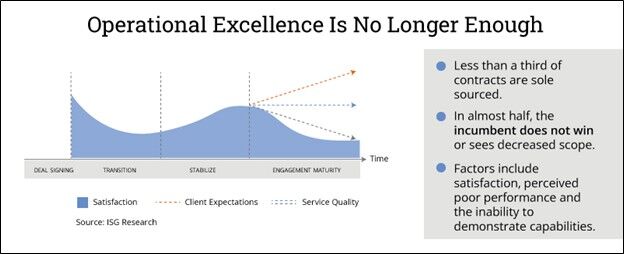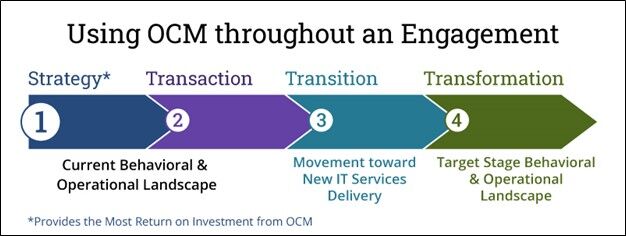Chances are, you’re in a relationship right now between a company and a provider that isn’t going very well. Often, we see gaps between what organizations expect from a managed-service provider (MSP) and what they believe they’re actually getting. That’s especially true when it comes to organizational change management (OCM) activities like communications and managing workforce transitions. Clients may be expected to handle the critical aspects of transition related to their employees, but MSPs can really model the way and provide thought leadership to elevate the partnership to new levels. The MSP typically has much more experience than its clients and needs to bring that experience as part of the service.
The demands and assumptions providers make about their clients aren’t talked about enough at the beginning of a transition, and they need to be confirmed, validated and adjusted over the life of the partnership. Otherwise, there’s a very real chance of losing the account. Providers often acknowledge they do set expectations in initial discussions with clients, but then they rarely go back to confirm progress is being made. Also, while clients may have experience with aspects of OCM, they don’t often have that experience specifically in sourcing contexts, which are sensitive and need to be handled with care.
Relationship Counseling for Companies and Providers
Think of this as relationship counseling between client and provider. Success on an account would look like one team with a common mission. Some things we’ve found in relationship studies point out areas that could be improved on both sides. We hear the most concerns about:
- Needing more flexibility than just what’s explicitly stated in the contract
- Having more trust in each other
- Providing more transparency
- Creating better understanding between client and provider, including more communication
- Listening more to each other and collaborating at all levels
ISG research shows only one in three providers get sole-source contract renewals. If competition is invited, in almost half the cases, the incumbent does not win or sees decreased scope. Three main reasons clients cite for this involve satisfaction, perceived poor performance, and the incumbent’s inability to demonstrate capabilities. Providers need to prepare early for negotiations and go beyond just achieving whatever operational excellence is expected. Invest in a strong, trusted relationship.

Preparing for Changes with Organizational Change Management
For example, companies often need extensive support when preparing for big changes. Providers can really step up their relationship building during these times. Instead, providers often focus almost solely on individuals who will be rebadged or who will directly interface with the provider, its systems or processes. But that’s only one subset of stakeholders and can leave others at the client organization feeling blindsided.
First-time outsourcers, in particular, need guidance from providers and expect advice from the MSP that does this on a regular basis. It isn’t enough to lay out the change plan once. You need to continuously come back to check in. Just holding sessions for process walkthroughs and then expecting the client to complete configuration workbooks and participate in many hours of knowledge transfer, testing, training, procedure-validation sessions, and other activities isn’t being mindful of the shared responsibility between both sides. In many cases, processes aren’t standardized across the client’s business, and the company needs high-touch assistance to get through all this work.
OCM can help with areas like aligning leaders on what needs to be done, providing a roadmap to the future, onboarding the project team, refining roles, creating/delivering change communications, ensuring the proper training, preparing employees for change impacts and more. The provider or client saying, “We have OCM,” doesn’t cut it. The efforts must include experience at actually managing the change journey for employees over the life of the transition and within the sourcing context. These are highly sensitive activities that require discipline.

Getting Both Sides on Board
Both entities need to assist with change readiness to fully empower employees. That means building awareness, providing knowledge on how to change, ensuring the abilities to change behaviors and skills, and providing reinforcement through redefined performance management. What employees will do in the future state is different from what they currently do, and adjustments should be made in the metrics. These efforts create joint accountability and better alignment of cultures, roles and responsibilities to become one team.
OCM can address gaps with leadership alignment, targeted communications, refinement and execution of transition plans, stakeholder and change-impact analyses, and more. It’s important to lay the foundation up front, in the strategy phase. ISG has numerous case studies on how we’ve helped various clients support major changes – enhancing relationships between clients and providers, customizing to focus on key areas, and sizing solutions for each client’s needs and budget. The greatest return on your investment with respect to OCM occurs with intentional activities during the strategy phase that are then reinforced over time.

Avoiding a Client-Provider Breakup
Clients and providers can avoid a nasty breakup by investing in relationship building throughout the partnership. That includes regular relationship reviews to align leadership, strategic investment at times where OCM is needed most, ongoing OCM activities to maintain and improve the relationship, and annual operational assessments to identify areas for improvement. Both sides must practice intentional, transparent and open communications and feedback to ensure things are staying on track – and this must occur at multiple levels of the partnership arrangement.
Contact us for more information.
